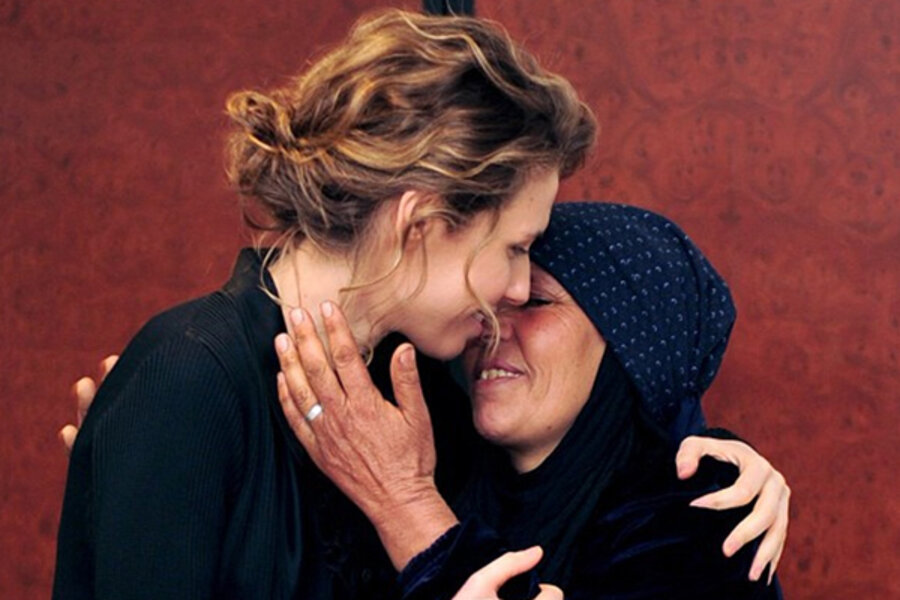Assad's Instagram account filters out Syria's war
Loading...
• A daily summary of global reports on security issues.
Taking advantage of Syria's war-driven media vacuum, President Bashar al-Assad is cranking up his public relations efforts in a way more associated with 20-somethings and teenagers: via Instagram.
The Syrian leader's recently launched account on the popular photo-sharing service paints a picture of Syria that manages "to erase most signs of a civil war which, according to the latest United Nations estimates, has now killed more than 100,000 people," writes The National Post of Toronto. The Post offers up a selection of photos published on the account, which show a smiling Mr. Assad and his wife, Asma, being greeted by adoring crowds in a variety of venues.
As of this morning, only one of the 70-plus photos published hint at any strife, showing Assad greeting people in the streets of Homs, one of the most war-torn cities in Syria. Though the people appear to be welcoming the smiling Assad, the buildings in the background show signs of damage.
The Post notes that "Whoever is monitoring the Instagram account seems to be deleting negative comments, although the odd criticism of the regime makes it through."
“What of the children? What of the death toll? What of the refugees? #propaganda,” reads one comment under a photo of Assad and his wife in a crowd of people.
“Your propaganda is not folling [sic] anyone,” reads another comment. “You will be caught and you will be killed. Best you run now.”
But the account also offers further evidence of growing confidence within Syria's government that it will weather the civil war. In comments made on Syria's Army Day today and published by Syrian state media, Assad said that ''Had we in Syria not been confident of victory, we would not have been able to remain steadfast and resist the agression [sic] for over two years."
The Instagram offensive by Assad – who already has Twitter and Facebook accounts as well – was slammed by the US State department, reports ABC News.
“This is nothing more than a despicable P.R. stunt,” spokesperson Marie Harf told reporters at the briefing [Wednesday]. “It’s repulsive that the Assad regime would use this to gloss over the brutality and suffering it’s causing, that — to see what’s really happening right now in Syria, to see the horrific atrocities in Homs and elsewhere, we would encourage people to take a look at unfiltered photos of what’s actually happening on the ground.”
However, showing "what's actually happening on the ground" is becoming harder than ever before, notes The Christian Science Monitor's Tom Peter. Mr. Peter explained yesterday that the conflict has created "an environment ripe for kidnapping" by various groups in Syria looking to make a quick buck from ransoming journalists -- effectively driving most foreign reporters out of the country.
Last Wednesday, armed men abducted Polish journalist Marcin Suder. According to media reports, militants took Mr. Suder from a media office in Idlib. An activist at the media center intervened in an attempt to stop the kidnappers, but he was beaten and hospitalized.
Even just several months ago, the abduction of a foreign reporter under these circumstances would have been unheard of, but kidnappings like Suder’s are rapidly undoing the idea that “safe houses” can exist in a place like Syria. ...
Even those who travel to northern Syria without experiencing any close calls, often leave saying they’re unwilling to return because they feel unsafe due to the massive number of foreign fighters and jihadists.
More than making it difficult, if not impossible for journalists to deliver on-the-ground reporting on one of the most brutal wars in decades, the cause of the problem is one that can only spell a dark and troubled future for Syria.
A glance at the Syria page on the website of journalist watchdog Reporters Without Borders (RWB) shows multiple accounts of abducted and missing journalists in just the past few months. RWB ranks Syria as one of the least safe countries for journalists, at 176 out of 179, with 24 journalists killed and 24 more imprisoned in the country since the war began in March 2011.








